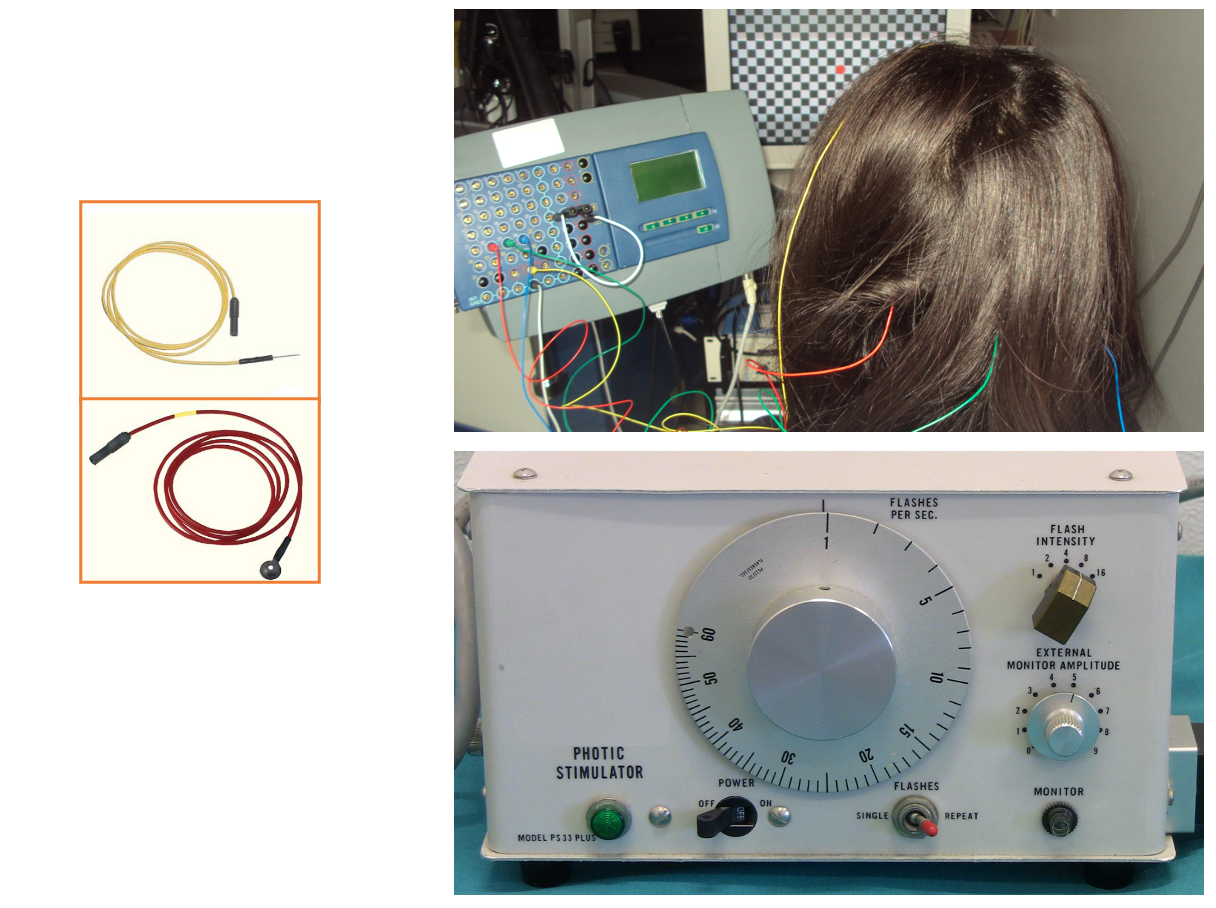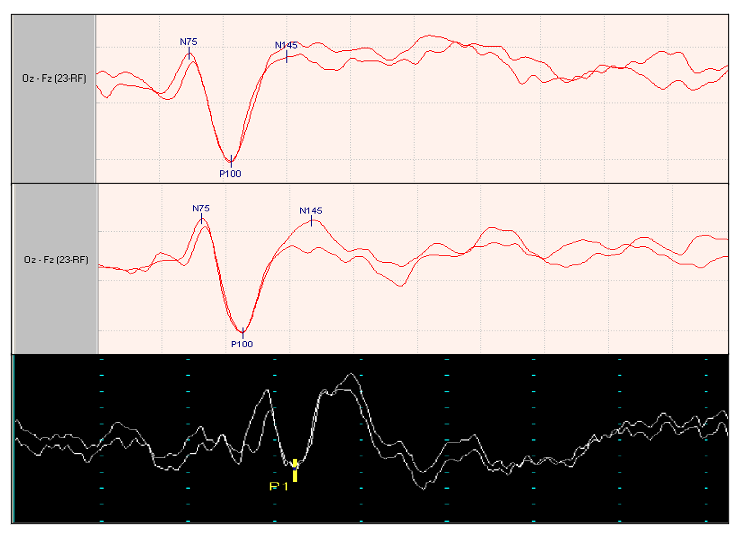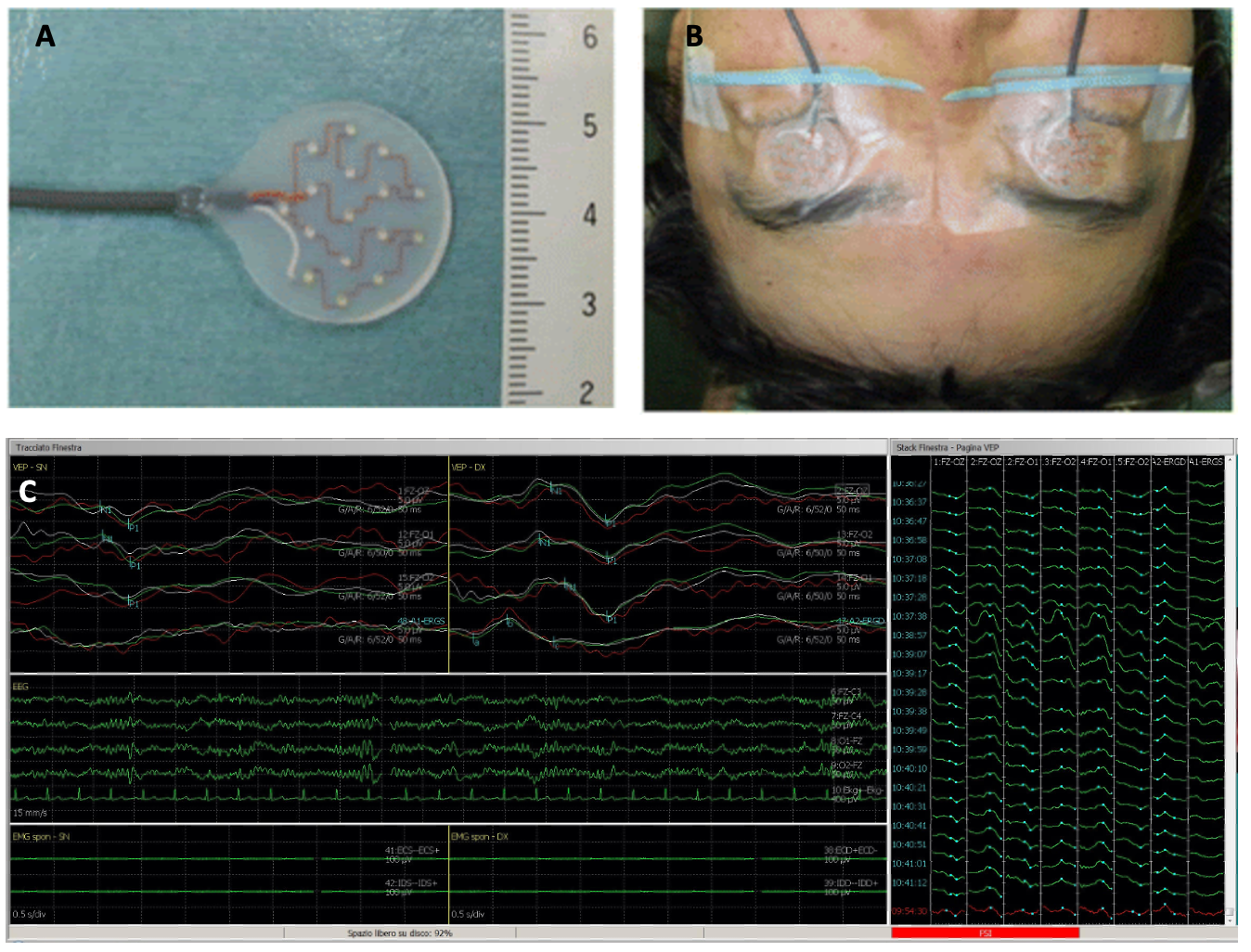[1]
Hoffmann MB, Brands J, Behrens-Baumann W, Bach M. VEP-based acuity assessment in low vision. Documenta ophthalmologica. Advances in ophthalmology. 2017 Dec:135(3):209-218. doi: 10.1007/s10633-017-9613-y. Epub 2017 Oct 4
[PubMed PMID: 28980154]
Level 3 (low-level) evidence
[2]
Hamilton R, Bach M, Heinrich SP, Hoffmann MB, Odom JV, McCulloch DL, Thompson DA. VEP estimation of visual acuity: a systematic review. Documenta ophthalmologica. Advances in ophthalmology. 2021 Feb:142(1):25-74. doi: 10.1007/s10633-020-09770-3. Epub 2020 Jun 2
[PubMed PMID: 32488810]
Level 3 (low-level) evidence
[3]
Patterson Gentile C, Joshi NR, Ciuffreda KJ, Arbogast KB, Master C, Aguirre GK. Developmental Effects on Pattern Visual Evoked Potentials Characterized by Principal Component Analysis. Translational vision science & technology. 2021 Apr 1:10(4):1. doi: 10.1167/tvst.10.4.1. Epub
[PubMed PMID: 34003980]
[4]
Zheng X, Xu G, Zhang K, Liang R, Yan W, Tian P, Jia Y, Zhang S, Du C. Assessment of Human Visual Acuity Using Visual Evoked Potential: A Review. Sensors (Basel, Switzerland). 2020 Sep 28:20(19):. doi: 10.3390/s20195542. Epub 2020 Sep 28
[PubMed PMID: 32998208]
[5]
Soares TS, Sacai PY, Berezovsky A, Rocha DM, Watanabe SE, Salomão SR. Pattern-reversal visual evoked potentials as a diagnostic tool for ocular malingering. Arquivos brasileiros de oftalmologia. 2016 Sep-Oct:79(5):303-307. doi: 10.5935/0004-2749.20160087. Epub
[PubMed PMID: 27982208]
[6]
Mahajan Y, Ching A, Watson T, Kim J, Davis C. Effect of sustained selective attention on steady-state visual evoked potentials. Experimental brain research. 2022 Jan:240(1):249-261. doi: 10.1007/s00221-021-06251-0. Epub 2021 Nov 2
[PubMed PMID: 34727219]
[7]
Hassankarimi H, Jafarzadehpur E, Mohammadi A, Noori SMR. Low-contrast Pattern-reversal Visual Evoked Potential in Different Spatial Frequencies. Journal of ophthalmic & vision research. 2020 Jul-Sep:15(3):362-371. doi: 10.18502/jovr.v15i3.7455. Epub 2020 Aug 6
[PubMed PMID: 32864067]
[8]
Montgomery DP, Hayden DJ, Chaloner FA, Cooke SF, Bear MF. Stimulus-Selective Response Plasticity in Primary Visual Cortex: Progress and Puzzles. Frontiers in neural circuits. 2021:15():815554. doi: 10.3389/fncir.2021.815554. Epub 2022 Jan 31
[PubMed PMID: 35173586]
[9]
Yang M, Jung TP, Han J, Xu M, Ming D. [A review of researches on decoding algorithms of steady-state visual evoked potentials]. Sheng wu yi xue gong cheng xue za zhi = Journal of biomedical engineering = Shengwu yixue gongchengxue zazhi. 2022 Apr 25:39(2):416-425. doi: 10.7507/1001-5515.202111066. Epub
[PubMed PMID: 35523564]
[10]
Kothari R, Singh S, Singh R, Shukla AK, Bokariya P. Influence of visual angle on pattern reversal visual evoked potentials. Oman journal of ophthalmology. 2014 Sep:7(3):120-5. doi: 10.4103/0974-620X.142593. Epub
[PubMed PMID: 25378875]
[11]
Dymond AM, Coger RW, Serafetinides EA. Data preprocessing applied to human average visual evoked potential P100-N140 amplitude, latency, and slope. Psychiatry research. 1980 Dec:3(3):315-22
[PubMed PMID: 6936725]
[12]
Yadav NK, Ludlam DP, Ciuffreda KJ. Effect of different stimulus configurations on the visual evoked potential (VEP). Documenta ophthalmologica. Advances in ophthalmology. 2012 Jun:124(3):177-96. doi: 10.1007/s10633-012-9319-0. Epub 2012 Mar 20
[PubMed PMID: 22426575]
Level 3 (low-level) evidence
[13]
Park SH, Park CY, Shin YJ, Jeong KS, Kim NH. Low Contrast Visual Evoked Potentials for Early Detection of Optic Neuritis. Frontiers in neurology. 2022:13():804395. doi: 10.3389/fneur.2022.804395. Epub 2022 Apr 29
[PubMed PMID: 35572925]
[14]
Thirunavu VM, Mohammad LM, Kandula V, Beestrum M, Lam SK. Vision Outcomes for Pediatric Patients With Optic Pathway Gliomas Associated With Neurofibromatosis Type I: A Systematic Review of the Clinical Evidence. Journal of pediatric hematology/oncology. 2021 May 1:43(4):135-143. doi: 10.1097/MPH.0000000000002060. Epub
[PubMed PMID: 33480655]
Level 1 (high-level) evidence
[15]
Leocani L, Guerrieri S, Comi G. Visual Evoked Potentials as a Biomarker in Multiple Sclerosis and Associated Optic Neuritis. Journal of neuro-ophthalmology : the official journal of the North American Neuro-Ophthalmology Society. 2018 Sep:38(3):350-357. doi: 10.1097/WNO.0000000000000704. Epub
[PubMed PMID: 30106802]
[16]
Wang Y, Wu DZ, Wu LZ, Chen YZ. Visual field versus visual evoked potentials in maculopathies and optic neuropathies. Yan ke xue bao = Eye science. 1989 Jun:5(1-2):52-9
[PubMed PMID: 2485746]
[17]
Jurkute N, Robson AG. Electrophysiology in neuro-ophthalmology. Handbook of clinical neurology. 2021:178():79-96. doi: 10.1016/B978-0-12-821377-3.00019-2. Epub
[PubMed PMID: 33832688]
[18]
Marcar VL, Battegay E, Schmidt D, Cheetham M. Parallel processing in human visual cortex revealed through the influence of their neural responses on the visual evoked potential. Vision research. 2022 Apr:193():107994. doi: 10.1016/j.visres.2021.107994. Epub 2021 Dec 31
[PubMed PMID: 34979298]
[19]
Eklund A, Huang-Link Y, Kovácsovics B, Dahle C, Vrethem M, Lind J. OCT and VEP correlate to disability in secondary progressive multiple sclerosis. Multiple sclerosis and related disorders. 2022 Dec:68():104255. doi: 10.1016/j.msard.2022.104255. Epub 2022 Oct 19
[PubMed PMID: 36544315]
[20]
Oh J, Vidal-Jordana A, Montalban X. Multiple sclerosis: clinical aspects. Current opinion in neurology. 2018 Dec:31(6):752-759. doi: 10.1097/WCO.0000000000000622. Epub
[PubMed PMID: 30300239]
Level 3 (low-level) evidence
[21]
de Seze J, Bigaut K. Multiple sclerosis diagnostic criteria: From poser to the 2017 revised McDonald criteria. Presse medicale (Paris, France : 1983). 2021 Jun:50(2):104089. doi: 10.1016/j.lpm.2021.104089. Epub 2021 Oct 28
[PubMed PMID: 34718114]
[22]
Backner Y, Petrou P, Glick-Shames H, Raz N, Zimmermann H, Jost R, Scheel M, Paul F, Karussis D, Levin N. Vision and Vision-Related Measures in Progressive Multiple Sclerosis. Frontiers in neurology. 2019:10():455. doi: 10.3389/fneur.2019.00455. Epub 2019 May 3
[PubMed PMID: 31130910]
[23]
Barbano L, Ziccardi L, Parisi V. Correlations between visual morphological, electrophysiological, and acuity changes in chronic non-arteritic ischemic optic neuropathy. Graefe's archive for clinical and experimental ophthalmology = Albrecht von Graefes Archiv fur klinische und experimentelle Ophthalmologie. 2021 May:259(5):1297-1308. doi: 10.1007/s00417-020-05023-w. Epub 2021 Jan 7
[PubMed PMID: 33415352]
[24]
Jayaraman M, Gandhi RA, Ravi P, Sen P. Multifocal visual evoked potential in optic neuritis, ischemic optic neuropathy and compressive optic neuropathy. Indian journal of ophthalmology. 2014 Mar:62(3):299-304. doi: 10.4103/0301-4738.118452. Epub
[PubMed PMID: 24088641]
[25]
Dotto PF, Berezovsky A, Sacai PY, Rocha DM, Fernandes AG, Salomão SR. Visual function assessed by visually evoked potentials in adults with orbital and other primary intracranial tumors. European journal of ophthalmology. 2021 May:31(3):1351-1360. doi: 10.1177/1120672120925643. Epub 2020 May 29
[PubMed PMID: 32468859]
[26]
Bowman R, Walters B, Smith V, Prise KL, Handley SE, Green K, Mankad K, O'Hare P, Dahl C, Jorgensen M, Opocher E, Hargrave D, Thompson DA. Visual outcomes and predictors in optic pathway glioma: a single centre study. Eye (London, England). 2023 Apr:37(6):1178-1183. doi: 10.1038/s41433-022-02096-1. Epub 2022 May 13
[PubMed PMID: 35562551]
[27]
Tăbăcaru B, Stanca HT. Further advances in the diagnosis and treatment of Leber's Hereditary Optic Neuropathy - a review. Romanian journal of ophthalmology. 2022 Jan-Mar:66(1):13-16. doi: 10.22336/rjo.2022.4. Epub
[PubMed PMID: 35531455]
Level 3 (low-level) evidence
[28]
Ziccardi L, Cioffi E, Barbano L, Gioiosa V, Falsini B, Casali C, Parisi V. Macular Morpho-Functional and Visual Pathways Functional Assessment in Patients with Spinocerebellar Type 1 Ataxia with or without Neurological Signs. Journal of clinical medicine. 2021 Nov 12:10(22):. doi: 10.3390/jcm10225271. Epub 2021 Nov 12
[PubMed PMID: 34830553]
[29]
Rodríguez-Labrada R, Velázquez-Pérez L, Ortega-Sánchez R, Peña-Acosta A, Vázquez-Mojena Y, Canales-Ochoa N, Medrano-Montero J, Torres-Vega R, González-Zaldivar Y. Insights into cognitive decline in spinocerebellar Ataxia type 2: a P300 event-related brain potential study. Cerebellum & ataxias. 2019:6():3. doi: 10.1186/s40673-019-0097-2. Epub 2019 Mar 4
[PubMed PMID: 30873287]
[30]
MacDonald DB, Dong CC, Uribe A. Intraoperative evoked potential techniques. Handbook of clinical neurology. 2022:186():39-65. doi: 10.1016/B978-0-12-819826-1.00012-0. Epub
[PubMed PMID: 35772897]
[31]
Zhu H, Qiao N, Yang X, Li C, Ma G, Kang J, Liu C, Cao L, Zhang Y, Gui S. The clinical application of intraoperative visual evoked potential in recurrent craniopharyngiomas resected by extended endoscopic endonasal surgery. Clinical neurology and neurosurgery. 2022 Mar:214():107149. doi: 10.1016/j.clineuro.2022.107149. Epub 2022 Jan 29
[PubMed PMID: 35151969]
Level 2 (mid-level) evidence
[32]
Clauser LC, Tieghi R, Galie' M, Franco F, Carinci F. Surgical decompression in endocrine orbitopathy. Visual evoked potential evaluation and effect on the optic nerve. Journal of cranio-maxillo-facial surgery : official publication of the European Association for Cranio-Maxillo-Facial Surgery. 2012 Oct:40(7):621-5. doi: 10.1016/j.jcms.2012.01.027. Epub 2012 Mar 17
[PubMed PMID: 22424910]
[33]
Gutowski KA. Evidence-Based Medicine: Abdominoplasty. Plastic and reconstructive surgery. 2018 Feb:141(2):286e-299e. doi: 10.1097/PRS.0000000000004232. Epub
[PubMed PMID: 29373443]


